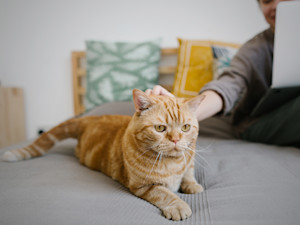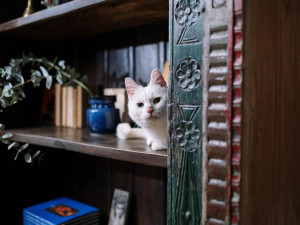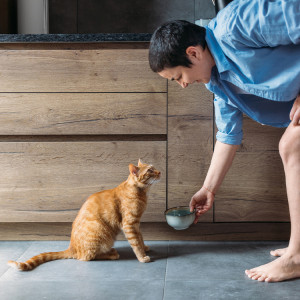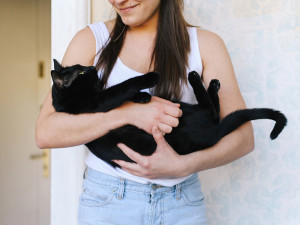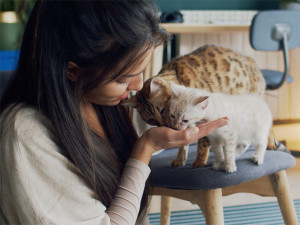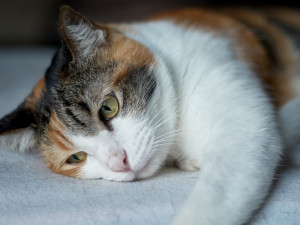What to Know About Eye Infections In Cats
Cats’ eyes are strikingly beautiful, but goopy, irritated eyes are not

Share Article
A cat’s eyes are one of their most striking features. Whether blue, green, hazel or yellow, their crystal-clear irises demand notice (like Liz-Taylor-lavender-eyes-level notice). But sometimes those beautiful eyes become cloudy, goopy, swollen or squinty. These changes could indicate an infection affecting the eyes.
Cats can get infections in or around their eyes for a variety of reasons. Most infections will resolve with basic care and medication, but some can recur or cause enough damage to result in blindness. But don’t worry: being aware of what to watch for and when to go to your vet can help head off problems before they get to the worst-case scenario.
What are the symptoms of an eye infection in a cat?
Unlike many other health issues, eye infections in cats tend to be pretty obvious – it’s hard to hide crusty, puffy eyes. Other symptoms include the following:
Increased discharge, often whiteish or greenish
Reddened whites of the eye
Cloudy or blueish surface of the eye
A defect on the surface of the eye
Bulging of the eyeball
Pawing at the eyes
Most cats with eye infections will be in pain, too. Cats show signs of eye pain by hiding, shying away from being petted, having difficulty eating or vocalising. Some cats will want to rub their gross eyes on you because the pressure feels good.
What causes a cat’s eye to look cloudy?
The clear surface of the eye, called the cornea, should be smooth and shiny. A corneal ulcer or erosion can cause this normally pristine surface to have a divot, flattening or discolouration. Corneal ulcers occur for many reasons, but some of the most common ones are trauma, viral upper respiratory infection, exposure to caustic agents (such as soap or chemicals), and foreign material. Not all corneal ulcers are infected, but they are a break in the eye’s natural defences and can become infected.
Sometimes, the clear part of a cat’s eye will appear hazy, whitish or bluish, but may not have a defect on the surface. This could be due to uveitis, which is a general term for inflammation within the eye. Uveitis can be frustrating because there are many possible causes for it, and some of those causes don’t even originate in the eye.
Uveitis caused by infection is usually due to a penetrating injury, such as a cat claw to the eye (ouch) or a very deep corneal ulcer. Some systemic infectious diseases – including feline infectious peritonitis, feline leukaemia, feline immunodeficiency virus, toxoplasmosis and certain fungal infections – can affect the eyes and cause uveitis as well.
What can cause a cat’s eyes to look swollen?
Inflammation of the tissues around a cat’s eyes can make them appear swollen. Puffy eyelids are commonly associated with either viral or bacterial upper respiratory infections. Some cats will get these infections directly from a sick cat. Other cats acquire viral infections when they are young and develop symptoms again during times of stress.
Less frequently, the tissues within the eye socket will get infected. These types of infections are very painful and will cause the eyeball to bulge. This can be caused by a migrating foreign body or by a deep dental infection. This problem is commonly known as a retrobulbar abscess or retrobulbar cellulitis.
How are eye infections in cats diagnosed and treated?
After a general physical examination and magnified direct examination of the eyes, the most common initial tests for evaluating eye issues are fluorescein staining, Schirmer tear testing and checking the pressure within the eye.
Fluorescein stain is a special dye that is applied directly to the surface of the eye. The surface of a healthy eye is extremely smooth, so the dye should wash away completely when the eye is flushed. If there is a corneal ulcer present, the dye will stick to it and glow under black light. The Schirmer tear test checks for normal tear production. Decreased tear formation results in a dry eye that is prone to ulcers or other problems that could lead to infection.
As part of the evaluation for eye issues, veterinarians will often use tonometry to check the pressure in a cat’s eye. Low pressure in the eye is associated with uveitis or a puncture of the eye, while high pressure can be due to a retrobulbar abscess or glaucoma. Your vet may recommend an ultrasound, CT scan or MRI to help make sure there are no scary problems, such as a tumour hiding in or behind the eye.
Treatment recommendations will depend on the disease. Topical or oral antibiotics may be recommended if a bacterial infection is suspected. An E-collar (cone) may be needed for cats who are rubbing their eyes and at risk of worsening their problems. Some cats with more serious issues may need a surgical procedure to drain an abscess or help the surface of the eye heal.
How can cat eye infections be prevented?
Cats love exploring the world and getting into unexpected trouble, so it may be impossible to prevent every eye issue. Keeping cats indoors as much as possible – out of the cycle of territorial drama and illness – is a good first step. In cats with a history of upper respiratory infections, maintaining a low-stress environment and recognising the early symptoms of their infections can help to keep things from progressing.

Dr. Bartley Harrison, DVM
Dr. Bartley Harrison, DVM, is a veterinarian with more than 15 years of experience in Emergency Medicine. He has worked in both large and small emergency and specialty veterinary practices treating a variety of species.
Related articles
![kittens licking woman's hand]()
Curious Cat Behaviour: Why Does My Cat Lick Me?
Hey, everybody’s got their thing
![kitten lying on the floor breathing through his mouth]()
Is My Cat... Panting?
“Cats don’t pant to cool off like dogs do.” Unless your pet is catching their breath after doing the zoomies, Dr Gary Weitzman says panting could be cause for concern
What to Know About Runny Noses in Cats
Nasal discharge doesn’t sound cute, but you need to know what to look out for
![grey and white cat with tongue sticking out]()
Why Is Your Cat Vomiting Like They Partied All Night?
Here’s when you should worry if your cat is throwing up

